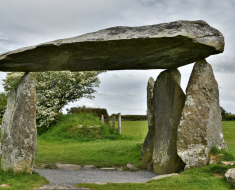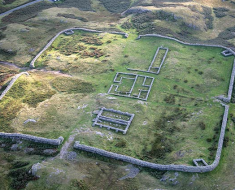In the UK, roads are as old as the Romans or, as archaeologists recently discovered in Shropshire, even older.
The requirement to move people or goods from one location to another efficiently and safely is as old as the hills the roads cross. The United Kingdom has a modern road network totalling just over 250,000 miles of paved roads.
The earliest roads specifically built for transit were during the British Iron Age, and the Romans expanded on this during their period of occupation, challenging the long-held perception that the Romans were the first road builders in the UK.
Contents
- Iron Age Road Builders
- Roman Roads
- Modern Roman Roads You’ve Probably Driven On
- Coach Roads
- Roads or Routes?
- The Origin of Finger Posts
- There’s No Such Thing as a Modern Road
The 20th century saw the real development of the road network in Britain. It brought with it regulations like the Highway Code, road signs and markers, and legislation for traffic offences, some of which built on earlier infrastructures.
Many earlier highways and byways from the pre-industrial era were incorporated into this system, as were the remnants and position of much earlier Roman roads.
Iron Age Road Builders
For a long time, historians and experts in landscape and archaeology believed that it was the Romans who brought properly constructed roads to Britain.
That is, until the discovery of a metalled and cambered road in a quarry in Shropshire, which dates to the first century BC. That was a good century before the Romans arrived.

The road was unearthed at Bayston Hill Quarry near Shrewsbury; this quarry is owned by road-builders, Tarmac, an irony not lost on the archaeologists and media who descended on the site.
The road contained brushwood, a deep clay foundation and cobbles taken from the River Severn; it was six metres wide and 1.5 metres high. Initially, the road was attributed to a period post the Roman invasion, although it didn’t quite fit with the known Roman road network.
Read More: Ancient Trackways: Walking in the Footsteps of Neolithic People
Archaeologists discovered from samples of the brushwood and sediment that the road was built in several phases, the latest of which was a good century before the Roman invasion in AD43.
The findings correlate with other evidence of hard surfaces laid down in Iron Age settlements. Ruts in the road add to the evidence that it could have been a trade route suggested by some experts to connect Wrekin Hill to the Ordovices further to the west.
Remains of animal dung and dung beetles point to the road existing as a route – probably a drove for livestock – before Iron Age man upgraded it with a hard surface.
Roman Roads
The Romans occupied Britannia for nearly four centuries from AD43 to AD410. They constructed around 2,000 miles of paved roads running between two towns or cities to move soldiers and also for trade and commerce.

After Roman rule ended, many roads remained, and some have been absorbed into the UK’s national road network. In Roman times, the Fosse Way linked Exeter with Lincoln in a relatively straight line. Not all the road remains in the 21st century.
Modern Roman Roads You’ve Probably Driven On
However, large sections can still be found on modern highways such as the A46 from Lincoln to Leicester, the B4455 through Warwickshire, the A429 through Gloucestershire to Cirencester and the A37 in Somerset near Ilchester.
Read More: The Forgotten Roman Roads
Watling Street left northwest London and headed towards Wales, a route now occupied by the A5. A southern section also leaves southeast London and heads towards Dover, currently the modern-day A2.

Connecting the Fosse Way and Watling Street is Akeman Street, parts of which are now the A41 between Berkhamsted and Bicester.
Ancient
Pye Road originated at Caistor St Edmund just outside Norwich and connected the city with the Roman capital of Colchester, later extended to the new Roman capital of London.
This route is now shadowed by the A140, which leaves Norwich and heads south through Suffolk and is eventually picked up by the A118 in northeast London and sections of the Whitechapel Road heading towards the city centre.
Read more: Crop Marks, Natures’ History Trail
However, some of the best-preserved Roman roads which have not been subsumed by tarmac are the Blackstone Edge paved road that crosses the Pennines and a road crossing Tideswell Moor to Whiston in Yorkshire. These roads provide an opportunity to look at the quality of Roman road-building.
Coach Roads
In 1706 the first stagecoach route was created between York and London. It’s funny to think that there was no coherent or established road network in the UK after the Romans for literally hundreds of years.

One of the earliest and most famous routes was from London to Brighton, which was developed from the remains of a Roman road. Another major coaching route was the A30 from London to Cornwall and the Great North Road from London to Scotland.
Read More: The Largest Pre-Historic Hillforts you Should Visit
These modern roads follow the original coaching routes for sections of their journey, and it’s easy to spot them by the presence of coaching inns where horses were rested and changed.
Even in towns and villages with modern bypasses, the clues are ever-present with names like London Road or the name of the next large town, and pubs and inns called ‘The Coach and Horses’ or ‘The Travellers Rest’.
Roads or Routes?
Pre-industrial revolution, there were many tracks and byways that linked villages and properties, which were also used for driving livestock. Some of these have been adopted into the road network, and some haven’t.

Many were created simply for ease of movement between two points, and this can be seen in the structure and design of modern lanes and C roads, many of which take a track which modern-day roadbuilders would not choose for safety reasons.
Some old routes were never upgraded into roads and have either disappeared altogether or dissolved into bridlepaths or footpaths, their previous function no longer needed.
The Origin of Finger Posts
Finger posts first appeared in the UK in 1697 when legislation passed allowing magistrates to place direction posts at cross-highways or crossroads. Finger posts can have several arms, known as fingers (hence the name) and were traditionally made of wood or cast iron with black letters on a white background.

Not just used for roads, finger posts are often signage for footpaths, bridle paths, and canals. The oldest finger post still in existence, although preserved in a museum with a replica in place, is near Chipping Campden in Gloucestershire and dates to 1669 and points to Oxford, Warwickshire and Gloucester, represented as ‘Woster’ and ‘Gloster’.
The Highways Act of 1766 and the Turnpike Roads Act of 1773 made the use of finger posts on turnpike roads compulsory.
Turnpike Trusts
Turnpike Trusts began in the 17th century and developed apace in the 18th and 19th centuries, peaking around 1830. Parliament empowered turnpike trusts to collect road tolls used to maintain a road (sound familiar?!), and in the 1830s, there were more than one thousand trusts doing just that in England and Wales, with nearly 8,000 tollgates.
Read More: Do You Live Near One? Turnpike Roads & Cottages
The very first turnpike road was a section of the London to Chester road between Fornill and Stony Stratford. A separate Act of Parliament created each individual trust. The appointed trustees managed resources from each parish through which the road passed.

They combined these with tolls from visitors outside the parish who effectively paid to use the road with the collective funds used for highway maintenance.
Read More: Drove Roads, What are They?
The trustees were typically gentlemen of standing, local clergy and merchants who tended to have a vested interest in driving the scheme successfully. Turnpike trusts only declined because of the advent of the railways, which became the real transport focus until the beginning of the 20th century when the combustion engine-powered motor car began to develop.

Roundly hated by local people who couldn’t move freely from village to village, there were great celebrations when a trust came to an end. Turnpike trusts leave behind a legacy that has shaped the framework of the primary road system in the UK plus, there is a rich heritage of names, milestones and old toll houses for the social and architectural historian.
There’s No Such Thing as a Modern Road
The UK’s road network developed in force during the second half of the 20th century when car ownership became achievable for most people and goods moved more by road than by rail.
Read More: A Trip Along Watling Street, The Longest Roman Road in Britain
The development of the current road network in the UK flourished during this time with improvements in signage, road safety and the control and development of road designs.
Alongside all this was legislation to regulate cars and drivers, criminalise certain activities and the continuing right to raise money from motorists for the upkeep of the roads they drove on.

However, there really is no such thing as a modern road. Many major and minor roads across the British Isles have their origins in much earlier roads or routes. Even the idea of levying a toll or fee to pay for upgrades and maintenance is not original, dating back several hundred years.
On a small island like Britain, new road schemes in the 21st century often uncover previous routes which have been lost in the mists of time. For centuries, man has sought to get from A to B via the most direct route possible – nothing changes!






